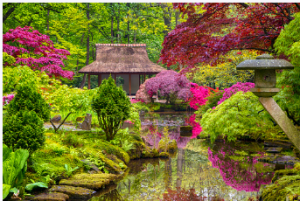Different Styles of Garden Design
If you plan on improving your garden, you should consider several factors. First, there are many different styles of gardens, including natural landscaping and formal French gardens. Choosing the right manner for your home and lifestyle will determine your project’s success.
 English landscape garden style
English landscape garden style
The English landscape garden style was first introduced in the early 18th century. It reformed gardens and landscapes in Britain and across the Continent.
Landscape gardens tended to have a very restricted range of plant species. They often featured bands of woodland and a lake. However, they also included oriental features such as pagodas and Chinese temples.
In addition, they reflected a European will to alter and modify the natural world. During the first half of the 18th century, there was a strong interest in the Orient. It was reflected in the work of French artists like Claude Lorrain.
At the same time, the idea of the natural world as a decorative object took hold. It was expressed in poetry and painting.
While the classical citations in the inscriptions reflected professional garden design, they also reflected the strength and creative self-consciousness of the Whig aristocracy. These wealthy patrons included Richard Temple, the 1st Viscount Cobham.
Towards the end of the 18th century, landscape gardeners began to take nature’s aestheticisation to the next level. For instance, they transformed streams into rivers and dams into lakes.
One of the most critical late eighteenth-century landscape gardeners was Lancelot “Capability” Brown. He began his career as a gardener at Stowe Gardens in Buckinghamshire under Charles Bridgeman. By 1748, he had become the head designer. His designs for the park were highly influential.
He developed the idea of woodland arrangements in fields based on lakes. The practical design approach and ecological knowledge mainly influenced Brown.
After his death, his influence continued in English landscape gardening. He created 250 gardens. Some of these designs are still used in the country today.
Another major contributor to the development of the English landscape garden style was William Kent. Kent worked on behalf of wealthy patrons. Many of his buildings reflect his respect for the architectural tradition of England and his liberal Enlightenment thinking.
English landscape gardening became more informal during the second half of the 18th century. As a result, critics began to call for a more varied style. They especially complained about the rigid regularity of the topiary.
French formal garden style
A formal French Garden Design SA is a garden design style that emphasises symmetry and balance. The technique was popular in Europe during the 16th and 17th centuries.
One of the most impressive formal gardens is the Palace of Versailles. These gardens feature 600 fountains and 35km of canals. They are the largest of their kind in the world. The design of the gardens is a combination of classical French technique and Italian renaissance influences.
Andre Le Notre is considered one of the greatest landscape architects ever. He designed the Garden of Versailles for King Louis XIV. His talents also extended to creating the garden at Chateau Fontainebleau, the Petit Trianon and the gardens at the Castle of Vaux le Vicomte.
In addition to his work at the Gardens of Versailles, Andre Le Notre also designed the Tuileries gardens in Paris. It was the most famous garden of his career.
He collaborated with Vaux le Vicomte to redesign the gardens. The back garden has a domed arbour as the centre of attention. It also has a round/concentric garden.
The parterre is one of the essential features of a French formal garden. This garden section is organised into symmetrically patterned flower beds bordered by trimmed hedges.
Another defining feature of a French renaissance garden is the waterways. Fountains, waterfalls and downhill streams are found in this garden style. Waterways, in particular, reinforce the symmetry of the design.
A significant change to the Versailles gardens occurred in the late seventeenth century. Louis XVI ordered large-scale replanting of the grounds. As a result, many trees from the previous reign of Louis XIV were removed.
However, there were other replanting of the gardens. When the Civil War broke out in France, expensive practices of the formal garden stopped.
The replanting of the Versailles garden in the early nineteenth century was another significant change. It was thought that the informality of the style would be less costly to maintain. But after the Commune of Paris was formed in 1883, the replanting was not allowed to continue.
Japanese rock garden
A Japanese rock garden is a dry landscape, usually designed to be a place for meditation and tranquillity. The landscape comprises a variety of rocks, gravel, sand, and some vegetation.
Stones are the essential elements of a Japanese rock garden. These can be large or small. They can represent various things, including trees, water, islands, and mountains.
Rocks are often arranged in endless ways. One example is the karesansui style, which features rocks placed like mountains. Another is the marsh style, which features stones that resemble rivers and lakes.
The Sesshutei Garden at Joei-ji Temple is based on the same landscape paintings. It is an excellent example of the Japanese rock garden.
While the Japanese rock garden may not be a natural environment, it is still alive and thriving. It is one of the few types of gardens that survive in the face of drought.
As a result, it is considered a living art. A rock Garden Design SA is regarded as a work of art because it can evoke images of mountains, lakes, waterfalls, fire, and more. Rock gardens are found in shrines, Zen Buddhist monasteries, and Zen temples.

